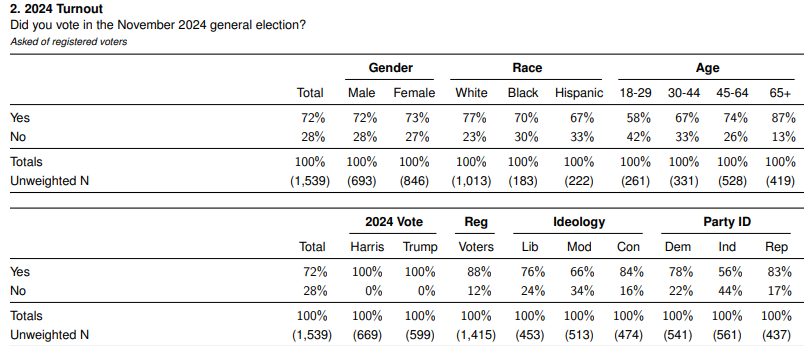My wife and I left for a river cruise in France the afternoon after the Presidential election; we already had the bad news that Americans had voted a corrupt criminal as their President and were grumpy about being forced to listen to Trump voters who were passengers on the boat.
But most of the cruisegoers turned out to be liberal Democrats from red states like Tennessee and Missouri who live appalled by the politics of their neighbors.
Since our return, I’ve been poring over the numbers, nationwide, state by state, and district by district, taking the bad with the good, trying to figure out what happened, and I want to share some of my thoughts.
There’s been a debate about the big drop in the Democratic vote from 2020, the “missing “ Democrats. Did too many simply sit home, or did they switch their votes to Trump? Today, I’ll write first about the national results, and will follow up with a second piece on New York.
Trying to Solve The Mystery of the Missing Dems
All the states and D.C. have certified their Presidential election results. The Cook Political Report National Popular Vote Tracker has the final vote tallies as follows:

Trump didn’t quite win 50% of the popular vote; he won 49.80 %( Cook corrected the above number to 49.8%) to Harris’s 48.33%, about 2.26 million votes more than Harris, 1.47 %. Third party candidates won nearly 3 million votes, about 1.9% of the popular vote. For the most part, third-party candidates did not have a material effect on the Presidential election in six of the seven swing states. (Michigan is a bit more complicated, and third-party candidates may have cost the Democrats the Senate seat in Pennsylvania, both of which I will discuss later in this article.)
The overall turnout from 2020 was down more than three million votes; Harris had six million fewer votes than Biden and Trump had three million more votes than he got in 2020, according to Wikipedia. Adjusted for the >1% increase in population in the U.S., if the turnout had been the same as 2020 the vote would have been about 160 million, five million more than how many voted on the presidential line in 2024.
Was It Low Dem Voter Turnout or Dems Voting for Trump?
Nate Cohn, the New York Times political analyst and polling guru, has argued that higher turnout would not have helped Harris much since many of those reluctant voters would have voted for Trump.
A look at the huge dropoff in some deep Blue states, versus Trump’s improvement, still shows that low Democratic turnout was the more significant factor. Regardless, big Democratic drops mattered little in deep Blue or deep Red states, but even a drop of a few voters, and a switch of a few voters, mattered a lot in the swing states.
Much of the depressed turnout for the Democrats was in the Blue states, where more Harris votes would not have affected the outcome of the election. In five deep Blue States, California, New York, Illinois, New Jersey, and Massachusetts, Harris had about 3.5 million fewer votes than Biden did in 2020, including 1.8 million fewer votes than Biden in California alone. Trump had about 570,000 more votes in those deep Blue states than he did in 2020.
This table compares the two Presidential votes for all voters in the five States:
| 2024 | 2020 | 2024 | 2020 | |||
| HARRIS | BIDEN | TRUMP | TRUMP | |||
| CALIFORNIA | 9.276 | 11.11 | 6.081 | 6.006 | ||
| NEW YORK | 4.619 | 5.244 | 3.578 | 3.252 | ||
| ILLINOIS | 3.062 | 3.471 | 2.449 | 2.446 | ||
| NEW JERSEY | 2.22 | 2.608 | 1.968 | 1.883 | ||
| MASSACHUSETTS | 2.126 | 2.382 | 1.251 | 1.167 | ||
| 21.303 | 24.815 | 15.33 | 14.75 | |||
The lower turnout had an impact on the national popular vote; Biden won those five states by more than ten million votes in 2020; the combination of the 3 ½ million Democratic vote drop in 2024 with Trump’s modest increase of 570,000 resulted in Harris winning these states by four million fewer votes than Biden – six million versus ten million.
Big drops for the Democrats in these states for the most part explained the results, not switching to Trump. In Illinois, for instance, Trump had only 3,000 more votes than he had in 2020, while Harris was down almost 400,000 from Biden. In New Jersey, Trump had 85,000 more votes than in 2020, but Harris had almost 400,000 fewer. In New York, Trump had more than 300,000 votes more than he had in 2020, and Harris was down 600,000 from Biden. She still won New York by a million votes.
The Democratic vote decline is clearly illustrated in this You Gov post-election poll that asks whether people voted:

Polls have margins of error, of course, but here 22% of Democrats stated they didn’t vote, while a smaller 17% of Republicans said they didn’t vote, along with 44% of independents. The final column, Unweighted N, relates to the raw number of responses- the numbers are weighted to reflect generally known figures like the fact that the number of people who identify as Democrats or Republicans is nearly equal and ethnic breakdowns. But the sample shows that fewer people who identify as Democrats voted in 2024 than Republicans.
It was a different story in the swing states. Here are the 2020 and 2024 results compared:
| 2020 | 2024 | |||
| BIDEN | TRUMP | HARRIS | TRUMP | |
| ARIZONA | 1.672 | 1.661 | 1.582 | 1.77 |
| GEORGIA | 2.473 | 2.461 | 2.548 | 2.663 |
| MICHIGAN | 2.804 | 2.649 | 2.736 | 2.816 |
| NEVADA | 0.703 | 0.669 | 0.705 | 0.751 |
| NORTH CAROLINA | 2.684 | 2.758 | 2.715 | 2.898 |
| PENNSYLVANIA | 3.458 | 3.377 | 3.423 | 3.543 |
| WISCONSIN | 1.63 | 1.61 | 1.668 | 1.697 |
In all seven states, Trump did better in 2024 than he did in 2020. Harris did better than Biden in Georgia, North Carolina, and Wisconsin (Nevada, too, by 2000 votes), but Trump’s turnout efforts were even more successful. Harris had fewer votes than Biden in Pennsylvania, Michigan, and especially Arizona, where her vote dropped more than five percentage points and she lost by more than five points. But even in Arizona, the exit polls in 2024 showed weaker turnout among Biden voters to be a bigger factor than vote switching.

The exit poll showed 45% of the Arizona electorate were 2020 Trump voters and 41% of the electorate were Biden voters. Since Biden won in 2020, 2024 should have been a rough match of 45-45 if virtually everyone had turned out again. Instead, about four points of the five points by which Trump won in 2024 came from Biden voters who didn’t turn out. Four percent of the Trump voters switched to Harris, and 6% of the Biden voters switched to Trump, so the voters who switched accounted for seven-tenths of one percent of Trump’s margin in 2024.
Third Party Candidates, Voters of Color Impact Swing States
In Michigan, Harris lost by 80,000 votes, and she had 68,000 fewer votes than Biden. Green Party candidate Jill Stein had over 44,000 votes, and Cornell West had nearly 7,000 votes. Anger among Arab-American voters in Michigan over the war in Gaza and the response of the Biden-Harris administration is estimated to have resulted in a switch of at least 22,000 votes from Biden to Trump, plus diversions of the vote to the Green Party. I agree the Arab-American vote was a factor, but exit polls in Michigan compared to 2020 showed the Black vote declined from 12% to 11%, and the small Latino vote swung from Biden to Trump.
In Pennsylvania, Harris lost by 120,000 votes to Trump, and had 35,000 fewer votes than Biden. The Green Party had over 34,000 votes compared to just 1,300 votes in 2020. Exit polls showed the Black vote dropped from 11% in 2020 to 8% in 2024. The Democrats in Pennsylvania and nationally need to understand carefully what was behind such a substantial drop in the Black vote there, including determining to what extent those exit polls were accurate, since that drop alone might have cost them Pennsylvania.
Senator Bob Casey of Pennsylvania lost his election by 15,000 votes to Dave McCormick, and the Green Party candidate for U.S. Senate got over 66,000 votes, 30,000 more than Jill Stein, the Green Party presidential candidate, got in Pennsylvania. Thank you, Green Party.
More successful campaigns by Harris in Michigan and Pennsylvania still wouldn’t have carried the day because they needed to win Wisconsin too, and Harris ran ahead of Biden in Wisconsin by 38,000 votes. Trump just ran even stronger there.
Assessments of the election that voters of color, especially Hispanics and Asians, shifted to Trump (Harris did win those voters, just not by anywhere near as much as 2020), were a factor in the Trump victory are accurate. In my view, however, “missing” Democrats who simply did not show up at the polls were a major factor too.
Dems Failed to Pass the Torch to Harris in a Timely Manner
One of the most significant questions asked in the Exit Polls was, when did you decide on your vote? Here’s the answer:

The responses show that 80% of the voters had decided on their vote before September and Trump was 2 percentage points ahead at that time, roughly the proportion by which he ultimately won ( 2% of 80% is 1.6%, and he won by about a point and a half).
The answer means the election was almost over by the time of the Democratic convention; Harris had to play major catch-up but wasn’t quite successful in doing that. It also means that decisions made by Joe Biden as to when to try to pass the torch to Harris likely should have been much sooner.
Discover more from Jim Brennan's Commentaries
Subscribe to get the latest posts sent to your email.

I broke my own rule by thinking a Harris Trump election would be a replay of Biden Trump. Harris carried the baggage of extreme reaction to inflation which I believed was the result of Biden putting mo ey into consumers’ pockets which they spent offsetting a depression. As Biden has subsequently said, he should’ve put his name on the checks.
My unanswered question is: do voters believe “checks and balances” will check Trump extremism or is the level of awareness of civic duty so low that it wasn’t a consideration by Trump voters. I don’t think all Trump voters are MAGA.
I am optimistic about Senate victories in swing states.